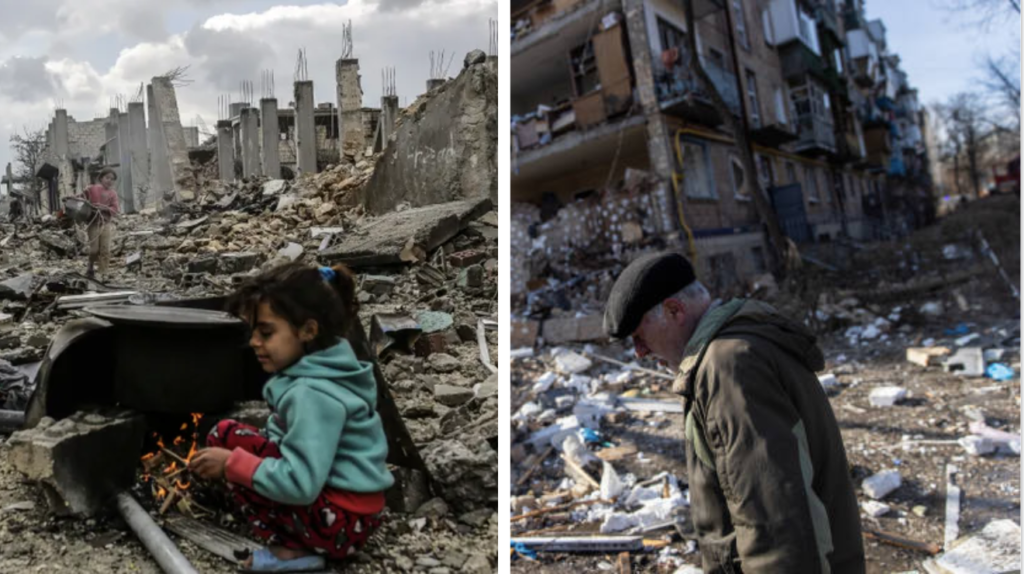Syria and Ukraine: Two Sides of the Same Coin?
As Russia continues its war against Ukraine, the similarities between Ukraine and Syria are striking. Specifically, Russia’s weaponization of civilians and refugees is a primary tactic that continues to be utilized to achieve geopolitical goals.

Photo credits: image from the Syrian Civil War (left) from The Guardian – image from the war in Ukraine (right) from GettyImages
On the side of a bombed-out home in the Syrian city of Binnish, a new mural appeared within hours of Russia’s unlawful invasion of Ukraine in late February. It shows Ukraine under attack by a brown Russian bear, controlled by an armed President Vladimir Putin. Surrounding the mural are piles of rubber littered around the ground, a stark reminder of Russia’s air campaign during Syria’s civil war. Aziz al-Asmar, one of the artists behind the painting, described the mural as “a message of solidarity with the people of Ukraine”.
“The Syrian regime and its Russian allies turned our houses into ruins for the past 11 years, causing many people to be displaced from their homes and villages” he told Al-Jazeera. “What is happening now in Ukraine is the continuation of Russia’s policy, and it won’t stop if the … international community do not unite and put an end to it.”
Rami al-Fares, who fled after the Syrian government and allied Russian forces bombed his town Kfar Nabel, watched Russia’s bombing of civilian infrastructure in the Ukrainian port city of Mariupol and was too reminded of the similarities.
“It was just like what we went through. The same tactics and scenes,” al-Fares told Al-Jazeera.
Indeed, as Russia continues its war against Ukraine, the similarities between Ukraine and Syria are striking. Specifically, Russia’s weaponization of civilians and refugees is a primary tactic that continues to be utilized to achieve geopolitical goals. In both conflicts, Russia forced civilians to move by inflicting massive damage on civilian infrastructure. Moreover, Moscow’s opening of humanitarian corridors and the subsequent bombing of them in both conflicts shows a pattern in war tactics. Though Syria and Ukraine have their own histories, they share the displacement of millions of citizens, inside their respective borders, because of Russian actions.
The Syrian Civil War
Since 2015, Russia’s tenure in Syria was marked by accusations that Moscow had “weaponized” streams of Syrian refugees and other displaced people from neighboring countries. Within the first few months of Russia’s military intervention in Syria, Moscow forced more than half a million Syrians to flee to Europe, resulting in one of the worst migrant crises that Europe ever experienced. Though a significant number of migrants had already reached Europe before Russia’s intervention, Moscow’s war considerably accelerated and worsened the crisis. Termed the 2015 European Migrant Crisis, or the Syrian Refugee Crisis, over one million refugees sought safety within Europe because of Russia’s intervention. This number, which was three to four times larger than the previous years, overwhelmed the European Union causing some nations to close their borders. How did this happen?
This migrant crisis was a product of Russia’s need to accomplish two main goals in Syria:
1) the survival of the Assad regime and 2) the retention and expansion of Russian influence in the Middle East. To Russia, Syria serves as a “platform of its engagement across the Middle East” that would assist Moscow with “advancing a worldview that seeks to further erode the U.S.-led, rules-based international order.” But getting in the way of achieving goals, were the various Sunni Arab tribes, who opposed the Syrian regime. To solve this, Moscow needed to get rid of them. Fabrice Balanche, an expert on Syria from the University of Lyon and a visiting fellow at the Washington Institute for Near East Policy, argued “that Russia along with Assad forces implemented a “conscious strategy of ethnic cleansing” against Sunni Arab tribes and other groups who opposed the Syrian regime.” This strategy incorporated the deliberate bombing of civilian infrastructure, like hospitals, to “push civilians to move” said Balanche. In Aleppo, according to Human Rights Watch, Russia’s bombing campaign killed more than 440 civilians, including more than 90 children. For years, this strategy continued in opposition-held cities, towns, and districts. Eventually, Russia and Syria did open up humanitarian corridors but most of them led to Idlib, one of the last opposition-held cities in Syria today. Funneling civilians into Idlib, where Russia’s bombing campaigns still continue, showcases Moscow’s manipulation of the migrant crisis and active use of civilian human lives as a tool to make strategic gains on the battlefield.
In 2020, Russia’s attempt to organize the first international refugee return center in Damascus may have indicated Moscow’s desire to alleviate the refugee crisis. However, this center “failed miserably” as it became apparent that Russia and other participating countries in the project were only there “to gain from the reconstruction boom in Syria, not pay for it, or simply to display political support for Assad”. This is evident in the number of refugees that Russia did not let in. According to Russia’s Ministry of Internal Affairs, until July 2019, only two Syrian citizens attained refugee status in Russia, while 694 people had temporary asylum. Of the two Syrians that received citizenship, one had received status before the war started. Moreover, although each year the number of refugees is decreasing, it is not because Syria has become safer, rather it is because “Russian officials are putting more and more obstacles in refugees’ paths.” One obstacle is Russian law. Under the law, a person is recognized as a refugee only “if, in his homeland, they have faced persecution “on the basis of race, religion, citizenship, nationality, membership in a particular social group, or political persuasion””. Since, Syrians aren’t fleeing from personal persecution “but rather from a war that does not differentiate between nationalities or religions but is dangerous to everyone,” Russia will not accept them. This means that Russia can continue its operations in Syria without having to bear the burden of taking in Syrian refugees.
Since 2011 more than 6.6 million Syrians were forced to leave their country, and another 6.7 million people remain internally displaced. In the last decade, Russia’s tactic of forcing civilian movement by bombing civilian structures and humanitarian corridors to accomplish regional and political goals in Syria has continued. But this tactic was not isolated to Syria alone.
The War in Ukraine
Currently, an estimated 3,557,245 refugees have left Ukraine amid Russia’s invasion. Filippo Grandi, the high commissioner of the United Nations’ refugee agency, stated “I have worked in refugee crises for almost 40 years, and I have rarely seen such an incredibly fast-rising exodus of people,”. This number will continue to rise as Russia escalates its attacks on Ukrainian cities and prevents humanitarian supplies from reaching major cities that it controls. The events unfolding right now in Ukraine are highly similar to that of Syria. Like in Syria, Putin’s continual weaponization of refugees, and migrants, highlights his will to sacrifice innocent civilians until peace talks conclude in agreements that favor Russian interests. This war also highlights the fact that this is a tactic that Putin has and will keep returning to if it means he can achieve political and regional gains.
This war is not the first event in Ukraine to produce a large wave of refugees at the hands of Russian military forces. Following Russia’s illegal annexation of Crimea in 2014, an armed conflict between Russian-backed separatist forces and the Ukrainian military, millions of Ukrainians fled to unoccupied territories in other parts of Ukraine. In July 2019, according to data from Ukraine’s Ministry of Social Policy, it was recorded that there were near “1.4 million registered IDPs in a country of 42 million people (excluding the population of what the United Nations refers to as the “temporarily occupied the Autonomous Republic of Crimea”)” making Ukrainians, “the 12th largest displaced population in the world.”
Much of Putin’s grievances towards Ukraine stem from his goal to prevent Ukraine from joining NATO and/or moving into the West’s sphere of influence. Attempting to consolidate Ukraine into Russia’s sphere of influence, as he did with Belarus, Putin instead was faced with multiple Ukrainian protests. The 2013 Euromaidan protest broke out because Ukrainian officials, who were loyal to Putin, refused to sign an economic agreement with the European Union, which would have pushed Ukraine close to Europe. The protests led to Russian-backed Ukrainian President Victor Yanukovych resigning and eventually the Verkhovna Rada, Ukraine’s parliament, elected an acting prime minister and acting president, who “promptly declared their goals of signing the association agreement and bringing the country closer to Europe.” Putin retaliated by invading Crimea. The West, in turn, placed sanctions on Russia, which angered Putin. Putin again retaliated by purposefully opening up well-guarded border crossings to Finland and Norway amid the 2015 Syrian refugee crisis. These checkpoints moved thousands of refugees, including those fleeing unrest in Central Asia, and forced a spillover into Western nations. A Russian guard even confessed to a Finnish News Agency that the Federal Security Service of the Russian Federation (FSB) has arranged asylum seeker access to the Finnish border. This type of organized activity, where the FSB decided when to send asylum seekers to the border, was Putin’s way of manipulating the migrant crisis to ensure that Europe would back off from Russia and Ukraine.
Putin’s tactic of manipulating migrants continues as the war now enters its 5th week. Currently, Russia and Ukraine have reached an agreement to create 8 humanitarian corridors. However, despite the corridors set up, “only two corridors leading out of the six cities- Kyiv, Kharkiv, Sumy and the southern urban centres of Mariupol, Volnovakha and Mykolayiv – would end up in Ukrainian territory.” This means that the other corridors would be handled by Russia, and ultimately the narrative of the war and the refugee crisis would be manipulated by Russian media. A spokesman for the Ukrainian President, Volodymyr Zelensky, even described this arrangement as “completely immoral” and that Ukrainians should have the right to evacuate Ukraine without Russian interference. They even added: “[Russia] wants to supply humanitarian aid for pictures on TV, and wants the corridors to lead in its direction.”
To make matter worse though some of those corridors aren’t even being used as Russia continues to prevent civilians from leaving some of the cities and instead shells them. For example in Mariupol, Russia refuses to allow the evacuation of civilians and the proposed route out of the city has, apparently, been mined. This “ apparent abuse of humanitarian corridors and subsequent breakdown in trust” reflects not only Russia’s war crimes but also Putin’s ability to turn these corridors into a real-life hostage situation that would potentially assist in making Kyiv concede to Russian demands. As of now, about 100,000 civilians are trapped in Mariupol with no food or water, with Ukraine’s chief prosecutor calling Russia’s siege on the city a “genocide”. If Russia continues this tactic in other cities, then Kyiv will eventually have no choice but to concede to Russian demands in order to save hundreds of thousands of Ukrainian lives. Though no one knows when this war will end and what type of agreement will be reached, what we do know is that Russia will continue to manipulate migrants to achieve its military and political goals.
When it comes to Russia’s military tactics, the similarities between Syria and Ukraine can not go unnoticed. In both conflicts, Putin demonstrates his willingness to mobilize refugees as tools of intimidation to accomplish political goals. The lessons learned in Syria, Moscow are repeating in Ukraine right now. As the death toll keeps rising, in both Syria and Ukraine, whether due to Russia’s military actions or politics, one thing is clear: the current war in Ukraine is not the first time that Russia has played with innocent lives and it won’t be the last.
Elizabeth Jefimova (she/her) is a first-year student MA student candidate in NYU’s International Relations program with a concentration in International Law. She received one BA in History and another in Chemistry from Brooklyn College in 2019. Following graduation, she received an MA in Oral History from Columbia University, where most of her work centered on veterans. At NYU, she is looking to study the impact that the United States security assistance programs play in fragile state reformation, particularly in Syria. Her other research interests include examining the role that Russia plays in the Middle East. In her free time, Elizabeth enjoys watching true crime documentaries and reading fantasy/adventure series similar to Game of Thrones.






